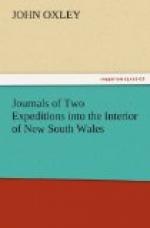Reduced as our provisions were, we could not resist the temptation of halting in this beautiful country for a couple of days, to allow us time to ascertain its precise situation, and to ride down the banks of the river northerly as far as we could go and return in one day. The banks of the river in our neighbourhood were low and grassy, with a margin of gravel and pebble stones; there were marks of flood to the height of about twelve feet, when the river would still be confined within its secondary banks, and not overflow the rich lands that border it. Its proper width in times of flood would be from six to eight hundred feet, its present and usual width is about two hundred feet. The blue gum trees in the neighbourhood were extremely fine, whilst that species of eucalyptus, which is vulgarly called the apple tree, and which we had not seen since we quitted the eastern coast, again made its appearance on the flats, and of large size; as was the casuarina filifolia, growing here and there on its immediate banks.
The day throughout was as fine as could be imagined, and it was spent with a more cheerful feeling than we had experienced since we quitted the depot on the Lachlan. The river running through the valley was named Bell’s River, in compliment to Brevet Major Bell, of the 48th Regiment; the valley Wellington Valley; and the stream on which we halted on Sunday, Molle’s Rivulet.
August 20.—The day proved as favourable as could be wished, and the observations placed our situation in lat. 32. 32. 45. S., and our compared long. 148. 51. 30. E., the variation of the needle being 8. 38. 38. E. A valuable discovery was made in the course of the day by the men who were out with the dogs, the hills bounding the east side of Wellington Vale being found of the purest limestone, of precisely similar quality with that found at Limestone Creek. We were never due north of that place, and it is more than probable that the same stratum extends on the same meridian through the country.
August 21—At eight o’clock, accompanied by Mr. Evans and Mr. Cunningham, set out on our intended excursion down the Macquarie River. Crossing Bell’s River in the valley, we came in a mile to where the steep rocky hills forming the west side of the vale advance their perpendicular cliffs directly over the river. These hills we soon rounded, and entered the vale north of them: I shall not in this place attempt to describe the rich and beautiful country that opened to our view in every direction. Alternate fine grazing hills, fertile flats and valleys, formed its general outline; whilst the river, an object to us of peculiar interest, was sometimes contracted to a width of from sixty to eighty feet between rocky cliffs of vast perpendicular height, and again expanded into noble and magnificent reaches of the width of at least two hundred feet, washing some of the richest tracts of land that can be found in any country; the banks were in those reaches low and shelving, and




